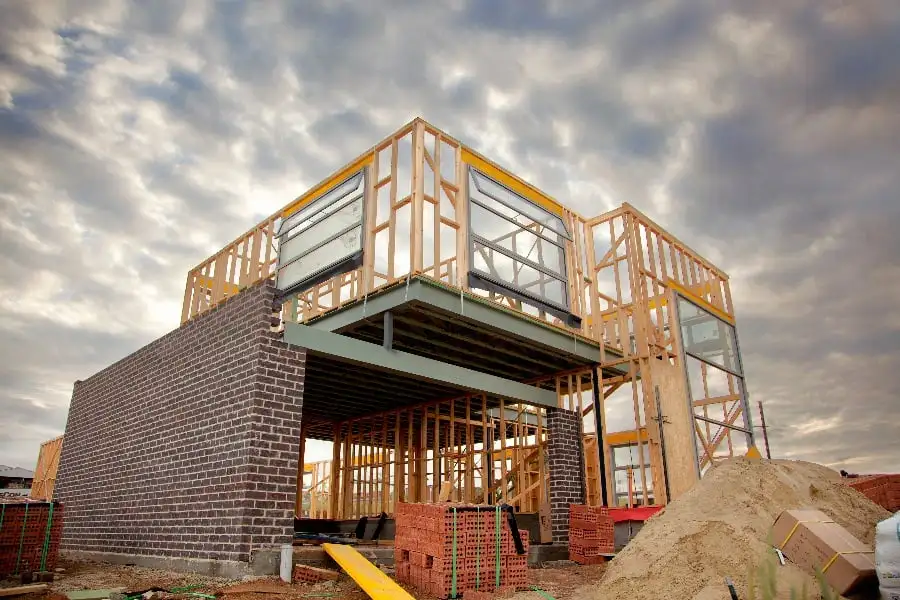Building a house in California is a huge cost that involves a lot of work. Among other factors, the construction cost for the house varies with location, size, and design. People would always like to know how much they need to spend into building a home in the state, and it would be more mind-blowing.
One would think that the price range in cost would cover from the average cost of building a house, which is around $400,000, to upwards of $2 million. Other factors that wonder what causes property prices to vary—from land costs to materials considered—and what it is as an added custom feature. Planning is key, and so is careful thought in regard to all the expenses before a project starts.
Average Cost to Build a House in California

It varies greatly based on the site, the size of the house, and its design-the cost of building a house in California varies. The average price was $1.35 million, ranging up and down the scale depending on the project. Here is a plain outline of costs:
Average Cost |
Hight Cost |
Low Cost |
| $1.35 million | $2.5 million | $40,000 |
Cost per square foot to build a house in California
California home construction costs vary according to the type of house and finishes chosen. Basic homes typically cost about $200-$400 per square foot, and custom homes with extensive upgrades tend to cost more. Costs can be summarized as follows:
Home size (square feet) |
Basic builder-grade home |
Custom home |
| 800 | $160,000 – $320,000 | $320,000-$480,000 |
| 1,000 | $200,000-$400,000 | $400,000 – $600,000 |
| 1,500 | $300,000-$600,000 | $600,000 – $900,000 |
| 1,800 | $360,000-$720,000 | $720,000 – $1,080,000 |
| 2,000 | $400,000-$800,000 | $800,000 – $1,200,000 |
| 2,500 | $500,000 – $1,000,000 | $1,000,000 – $1,500,000 |
| 3,000 | $600,000 – $1,200,000 | $1,200,000 – $1,800,000 |
| 3,500 | $700,000 – $1,400,000 | $1,400,000 – $2,100,000 |
| 4,000 | $800,000 – $1,600,000 | $1,600,000 – $2,400,000 |
California Home-Building Cost Factors
In California, many factors affect the home construction costs, and the variation can be significant. Below are the major factors influencing home-building costs for the state:
- Location: Construction costs are largely influenced by the location of the home. Construction in urban centers like Los Angeles or San Francisco is generally more expensive due to high land prices, labor rates, and building regulations. Land and labor costs are generally lower in rural or less-populated areas, but such locations usually demand more in infrastructural investment.
- Land Costs: In California, the price of land is sky-high in coastal cities or major metropolitan areas. The price of the lot is considered a sizable part of the overall project cost.
- Size and Design: Bigger homes or custom-designed houses will naturally require heftier expenditures. Design complexity, number of storeys, plus the features (pools, basements, and fancy finishes) you wish to include would all equate to higher expenses.
- Materials: One of the key cost determinants is the quality of materials used. Higher-end materials such as granite counters, hardwood floors, or imported finishes will raise costs. On the other hand, cheaper standard materials will help save a lot on expenses.
- Labor: Construction labor rates in California are among the highest in the nation, impacted by strong unions and high demand for skilled workers. Wages in areas like Los Angeles, San Francisco, and San Diego are particularly high when compared to the rest of California.
- Building Codes and Permits: California has strict building codes that mainly deal with earthquake safety, energy efficiency, and environmental concerns. Complying with these codes usually requires additional planning, materials, and engineering, all increasing cost. Permits can also take time and cost a lot.
- Extra Environmental Factors: California has different weather conditions and those with environmental challenges: earthquakes, wildfires, and droughts. This will call for the incorporation of extra safety factors and materials in order for homes to be safe and energy-efficient. For example, homes in high-risk fire areas may need certain fire-resistant materials, which can escalate costs.
- Utilities and Infrastructure: The provision of water, electricity and sewage services would be costly depending on the location, especially in rural areas. Even more initial costs will be incurred on homes requiring extra infrastructure features, such as private wells and septic systems or solar installations.
- Time of the Year: Also, the costs of construction depend on the time of year. Construction usually peaks during the spring and summer months, when building is often more expensive due to demand for both labor and material supply. The off-seasons may perhaps render some savings.
- Financing: The overall cost of building a house is dependent on interest rates and financing terms. When construction loan rates are high, the cost of the project too rises.
As a general rule, building a house in California may cost anywhere from $200 to $500 per square foot, with prices for custom designs and luxury homes leaping much higher. Building in an area with high demand versus one with its rural setting could also affect costs.
California Home-Building Cost Factors
Here are some different variables that constitute factors used in compiling the price of house construction in California. Each would be contributing to the overall costs. These cost determinants can assist you in making wise choices.
Buying land in California
Acquisition of land in California can be quite expensive. It depends on the placement of the land. In the desert, it may cost around $3,000 per acre. City-type land or coastal properties may exceed a whopping $1 million per acre.
The land survey is to be conducted before the buying process for proper identification of the boundaries of the property. There is extensive site preparation, such as digging, and this will also count as a price. Extra costs will include those necessary for taking care of widespread utilities or special topography.
Preparing the site
Ground preparation is one of the important steps toward building a site. At first, land needs leveling and grading. The difference in excavation costs usually occurs because of the type of terrain. If the land has rocky outcrops or is steep, the process becomes more expensive.
This ensures a good foundation for the home. The budget needed for excavation ranges from $1,500 to $10,000. Often, one needs to plan extra money for difficult areas. The process makes construction more comfortable and safer.
Foundation
The foundation is an integral part of your house. The foundation holds the entire house and acts as a strong support base for stability. A foundation may vary between $12,000 and $100,000. Different types of foundations include concrete slabs and basements.
Constructing a house on a slope may require additional support, such as retaining walls or pillars. Coastal constructions require raised foundations to avoid flooding, which adds to the cost. Having a strong foundation is necessary for a safe, durable home.
Framing & roof
After the foundation, the next proceeding will be framing, the actual building of the home. Costs for framing can vary from $20,000 to $60,000 depending on the size and complexity of the design.
Once the framing is finished, the next step is the roofing. The roofing cost depends on the materials used; asphalt shingles are the cheaper option, while tiles or metal roofs are going to be way more expensive. A roof is something that needs to be properly built because it protects the home from the elements.
Siding
Siding is the home cladding of the house. It protects and beautifies the house from the exterior. Basic siding materials, such as vinyl, cost around $8,000 to $26,000. Premium ones, such as bricks or stones, cost a fortune to consider.
So, siding influences the appearance of the house and sustains a significant performance lifetime. Vinyl is cheap and easy to maintain. Stone and brick are costly but provide everlasting protection. Siding is an integral factor toward the finish of the house exterior.
Electrical
Electrical wiring is a vital part of the structure of any house. This entails the installation of the wires carrying electricity, lighting, and appliances. The pricing for wiring a house can fluctuate from around $8000 up to about $18,000, which will depend on the size of the house and the complexity of the electrical system.
More intricate floor plans will generally be more expensive due to higher electrical needs. Qualified electricians should, therefore, always be considered in terms of safety. Electrical work will make sure that power is reliable in the home. A very important step to making the house fully functional.
Solar panels
Newly constructed homes in California will need to be fitted with solar panels. The solar system installation fees for an approximate 5 kW system stand between $12,500 and $17,300. This pricing does not account for the federal tax credit of 30%, which can lower the installation cost.
Panel usage lessens energy expenses by generating power from sunlight while meeting California energy efficiency mandates. In other words, solar proves to be a worthwhile investment for reducing long-term utility costs.
Plumbing & HVAC
It is imperative that plumbing be installed in any new house. The average plumbing installation price range is $8,000 to $12,000, which accommodates pipes, fittings, and fixtures such as sinks and toilets. A heating, ventilation, and air conditioning system is also important. Thermally efficient HVAC systems may be priced from $7,000 to $16,000, including ductwork. Pricing depends upon house size and the kind of system that is chosen. Plumbing, along with HVAC, is necessary in providing comfort and functional living spaces within a home.
Insulation & drywall
Insulation and drywall provide comfort as well as energy savings. The installation of insulation and drywall varies in cost between $12,000 and $40,000, depending on the size of the home and the materials. Different types of insulation, such as fiberglass or spray foam, also vary in price.
Good insulation permits the home to be energy-efficient by maintaining temperature. The drywall gives smooth finishes to the internal walls. These two materials are extremely important during the fine-tuning of a well-constructed, livable home.
Materials
The kind of materials that can be found in the construction of a home, usually, can highly influence its overall costs. These basic materials, such as carpets, carpet tiles, and laminate countertops, can be within the lower range, while premium-quality ones like granite countertops, hardwood flooring, and natural rock siding can be expensive.
Of course, the materials depend on the personal budget and tastes of an individual. Indeed, by using premium materials, one spends more, but from a long-term perspective, they might earn high returns by increasing property value and lifespan. The cost-versus-quality argument must be none the less considered on both external and internal materials.
Material |
Average Cost Range |
Average Cost |
| Lumber | $650–$1,100 per board ft. | $880 per board foot. |
| Framing lumber | $3–$12 per sq. ft. | $4.50 per square foot. |
| Concrete | $6–$12 per sq. ft. | $6 per square foot. |
| Drywall | $0.50–$1 | $0.75 per square foot. |
| Flooring | $2–$32 per sq. ft. | $20.50 per square foot. |
| Siding | $2–$50 per sq. ft. | $26 per square foot. |
| Insulation | $0.20–$2 per board ft. | $1.10 per board foot. |
| Roofing | $2–$180 per sq. ft. | $91 per square foot. |
| Electrical wiring | $3–$5 per sq. ft. | $4 per square foot. |
| Plumbing pipes | $5–$7 per lin. | $6 per linear foot. |
Labor Cost
The cost of labor for house construction in California varies by location, skill, and project complexity. Average labor costs can range from $30-$100 or higher per hour. Big cities tend to have a premium on labor costs.
Generally speaking, at least 30–50% of total construction costs can be labor. Because its work may be specialized, other auxiliary labor for the foundation or roof may incur a higher cost due to skill. Always obtain multiple bids from contractors to ensure the price you are being charged for the work needed is fair.
| Professional | Labor Cost per Hour |
| Excavating contractors | $100-$300 |
| Plumbers | $75-$150 |
| Electricians | $50 – $130 |
| Roofers | $30-$100 |
| Carpenters & framing contractors | $30-$100 |
| Siding contractors | $40 – $80 |
| Drywall contractors | $40-$100 |
| Painters | $20-$70 |
| Flooring installers | $20-$70 |
| HVAC installers | $75-$150 |
| Landscapers | $25-$50 |
Land
Land prices in California can be quite high depending on the region. For example, coastal and heavily urbanized areas like Los Angeles and San Francisco will price a small half-acre lot from about $50,000 up to $1 million. Less expensive properties are out in places like Fresno and Bakersfield, especially out in the desert.
Finding vacant lots in heavily urbanized areas can be quite a challenge, while purchasing a developed lot includes considering demolition costs. Take into account the price of land and its additional expenditures prior to purchase.
Cost to Build a House in California by House Style
Cost factors for California house styles can be huge since each style involves varying degrees of design elements, materials, and construction requirements. Here are the reasons behind these wide divergences in costs:
- Cape Cod: Properly sold houses are very expensive and normally priced at about $660,000, although they are highly known for their advantages in gaining elevation with square footage per foot at very minimal space taken.
- Contemporary: Typically, they are priced at about $1.35 million dollars. These homes are known for their modern design with open-space floor plans. Contemporary homes are being built from sustainable materials; these are very popular in California.
- Mediterranean: They feature distinct tile roofs and stucco siding, and it costs around $950,000 just to build these houses. Much of the coasts’ climates are similar to those in the Mediterranean; hence, architectural affinity.
- California Ranch: Typically, the average price of a single-story Californian ranch house is around $660,000. But the cost could increase a little further into those high-demand areas where space is a luxury.
- Victorian: Describe their work as beautiful woodwork, and due to the individuality and detailing, come at about 1.05 million dollars for construction. Since their designs become complex, they require specialized work.
Save money for Building a House in California
In California, for creating a house, a focused and strategic approach to saving money is a must. Here are a few other suggestions that might help you out:
- Open a Dedicated Savings Account: Create a house account separate from other savings; this will help you track your progress and ensure that you do not spend it on anything else.
- Automate Savings: Consider setting up an automatic monthly transfer into your savings account so that you always save a fixed amount for your house.
- Cut Down on Expenses: Go through your budget and identify which items you can cut back on, such as discretionary spending, cooking at home, or canceling unused subscriptions. Every little bit counts.
- New Income: Whenever you have extra income from tax returns, bonus checks, or gifts, consider that windfall and put a percentage of it straight into your house savings.
- Look Into Grants and Incentives: Look into applicable state or local programs providing financial assistance or tax credits to building energy-efficient or sustainable homes.
Final Words
Constructing a residence in California is rather expensive; however, the expenditure depends on the area of construction and the preferences of the homeowner. Expenses will vary for different land locations, permit costs, and the house itself. Planning should be done properly, knowing how much you will spend.
Budgeting properly will keep you on top of all costs. Research is useful whether the project is a little house or a bigger one. Managing everything properly will bring the dreams of many into reality in California.
(FAQs)
Q1. What is the building standards fee in California?
Fees for building standards in California are specific to each city and project. These would include amounts for permit processing, inspection, and state building codes, which range from $500 to even several thousand dollars.
Q2. How much does it cost to build a pool in California?
The average cost to build a swimming pool in California ranges between $30,000 and $75,000. The exact amount depends on the size, style, and materials regarding the pool; the luxury pools are yet more expensive.
Q3. How much does it cost to build a guest house in California?
For building a guest house in California, the budget generally ranges from $100,000 to $300,000, depending on its size and style as well as the location, having included permits and connections to utilities.
Q4. What is a guest house called in California?
In California, it is mainly known as an ADU, which means accessory dwelling unit, being a subsidiary home unit within the same property to serve guests, family members, or rental purposes.


